If you could use any three words to describe yourself, what would they be? Perhaps you would highlight your vocation — dancer, scientist, parent — or your place of origin — Taiwanese, Aboriginal, migrant. You might focus on values that are important to you — kindness, freedom, loyalty.
You might realize that some labels are easy to wear, the equivalent of a standard-issue business suit, commanding approval effortlessly. Yet other labels are truthful but more difficult to inhabit, like those that declare gender or sexual diversity, disability and other marginalized identities.
If you insist on authenticity, however difficult, you might be rewarded with an unshakable sense of self-affirmation. That’s the power of being seen on your own terms. And it’s a core premise of The Identity Project, a portrait series by photographer Sarah Deragon centered on LGBTQ individuals and the labels they use to define their gender and sexuality.
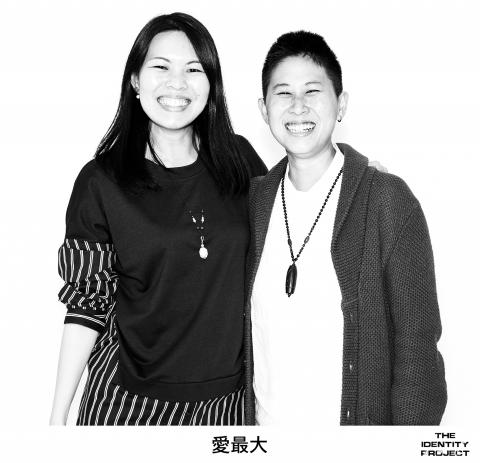
Photo courtesy of Sarah Deragon
THE IDENTITY PROJECT
The Identity Project began five years ago when Deragon found a way to radicalize an otherwise banal activity — posting a selfie on Facebook.
The selfie in question was a black-and-white studio portrait of Deragon, gaze leveled directly at the camera and hands holstering the straps of her tank top, accompanied by the label “Queer Femme.” The words were picked with care: “queer” for her political identity as an LGBTQ rights activist, and “femme” for the mode of gender presentation that made most sense to her.
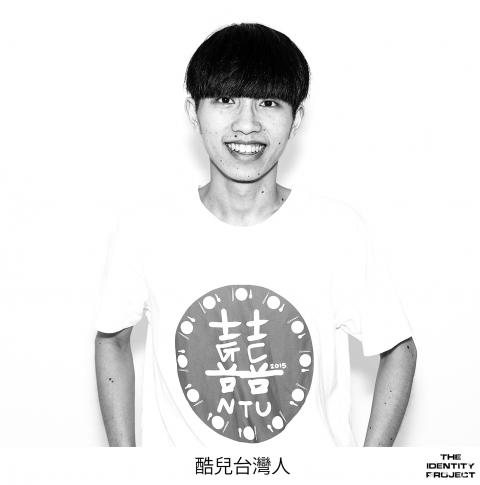
Photo courtesy of Sarah Deragon
Almost immediately, she was inundated with requests by members of the LGBTQ community in California’s Bay Area to be photographed with their own labels. Since then, Deragon has taken The Identity Project around the US and the world, first to the underground Queerfest in Saint Petersburg, Russia in 2015, and now to Taiwan for its fifth anniversary.
Photography that documents the lives of LGBTQ people is not new. Just last year, in tandem with Taipei’s pride parade, Singaporean photographer Leslie Kee’s “Out In Taiwan” exhibition shone a spotlight on out-and-proud LGBTQ individuals here. But the pairing of pithy words with images is unique, and Deragon says that this “doubly powerful” combination is what makes The Identity Project resonate with so many people.
“The thing that I love the most is the way the queer community plays with language. We just make up words and reclaim words. And language and naming yourself is really powerful,” Deragon tells the Taipei Times.
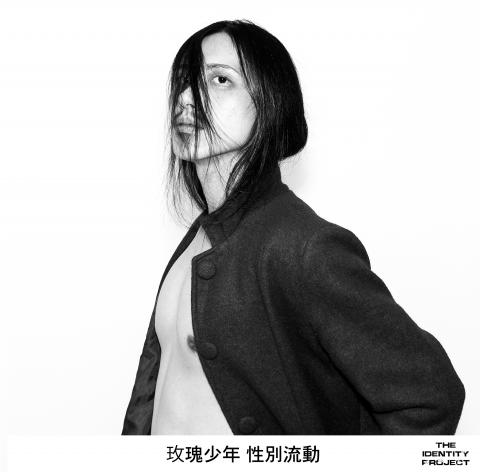
Photo courtesy of Sarah Deragon
For LGBTQ individuals, creative self-expression is as much a means of survival as it is an aesthetic choice. Homophobic, transphobic and heteronormative cultures can be, and have been, deadly.
According to an informal 2014 poll by the Intersex, Transgender and Transsexual People Care Association (性別不明關懷協會), as many as seven out of 10 transgender respondents had considered suicide. A 2012 survey by the Friendly Taiwan Alliance (友善台灣聯盟) of LGBTQ interest groups showed that 58 percent of respondents had been harmed by others because of their sexuality, of which 14 percent had experienced physical assault.
This is what makes the interstitial spaces and practices that LGBTQ people have carved out for themselves, where they are able to feel safe and seen, so sacrosanct — whether that means identifying as a “unicorn,” watching and rewatching Blue Gate Crossing (藍色大門) on your laptop, attending cell group in an LGBTQ-affirming church or performing at drag balls. The Identity Project captures this self-invented, do-it-yourself impulse of LGBTQ culture as displayed through the body and labels.
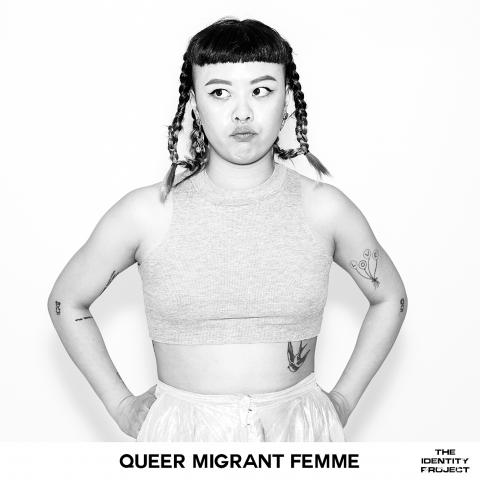
Photo courtesy of Sarah Deragon
Jonathan Ying Wang (王延瀚), who identifies as “Non-Binary Taiwanese American Gay,” appreciated the camaraderie on set.
Wang says LBGTQ people tend to be the minority in most situations, which is why “just being with another queer person, there’s this unspoken validation you have with each other. And that’s something I hope we can cultivate more within the queer community.”
Before professional photography, Deragon worked at the LGBTQ Frameline Film Festival in San Francisco, where she says she “really saw the power of seeing yourself reflected back in the movie theater.” As a queer photographer, the impact that she can now have on cultural representation is not lost on her.
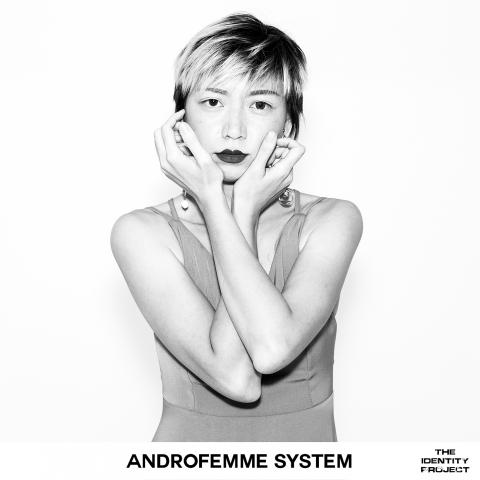
Photo courtesy of Sarah Deragon
“I’ve gotten letters from kids who are isolated in small towns and feeling suicidal and [are] just like, ‘I didn’t know that there was someone out there like me.’ I know it’s had a profound impact,” she says. Some younger participants of The Identity Project have even used her portraits as a way of coming out to their families.
TAIWANESE PRIDE
The idea of bringing The Identity Project to Taiwan was seeded by Deragon’s partner Leslie Wiser, a farmer, winemaker and activist of German-Taiwanese ancestry. (“I think if I were to do another label it’d be the ‘Half-Asian Gaysian,’” Wiser says.)
It’s a timely opportunity to diversify the range of identities featured in the project, given the erosion of protections for LGBTQ and other marginalized groups over the past two years under the Trump administration. Deragon says it has been “horrible” to witness the “amplification of hatred,” but adds that anti-LGBTQ sentiment has only strengthened the community’s resolve to fight for visibility.
Back home, Deragon and Wiser also followed Taiwanese voters’ rejection of marriage equality and LGBTQ-inclusive sex education in the Nov. 24 referendums. This formed part of their call to arms for the community here to participate in project.
While this is Deragon’s first visit to Taiwan, Wiser makes annual. Both have been struck by the openness and generosity of the LGBTQ community here, including acquaintances on social media who came through with offers of assistance from Portico Media (杰德影音), which is donating space for Deragon’s second photo shoot on Saturday; Andrea Toerien, who drew participants from her LGBTQ Facebook group; and translator Serene Lee (李靜宜).
At the A+A Studio (壹加壹攝計) in Taipei last Friday, students, teachers, drag performers, locals and expatriates turned out in force for The Identity Project’s first photo shoot. In the warmth of the studio, strangers fell comfortably into conversation the way that happens whenever and wherever queer folk are gathered in safe spaces. Girlfriends embraced, vegan beef jerky was shared and friends helped each other apply makeup and adjust outfits.
Deragon runs her shoot at a relaxed pace, and takes particular pleasure in working with those who “hate having their photo taken.” She patiently chips away at the ice by chatting about hobbies, outfits, labels, lovers and the “happy place” in your mind that will bring out an easy smile.
“I think the heart connection that I have with people is really reflected in the photos,” Deragon says. “I want to really be able to see them.”
Five years on from her first self-portrait, after photographing so many different people identifying with so many different labels, Deragon considers whether her own label of “Queer Femme” has changed.
“I might put ‘glitter’ or ‘sparkle’ in there,” she says, “but pretty much the same.”
To see more photos from The Identity Project, go to: www.identityprojectsf.com.
Those identifying under the LGBTQ spectrum are welcome to the second and final photo shoot for The Identity Project on Saturday, from 12pm to 4pm
Portico Media, 8F, 164, Dunhua S Rd Sec 2, Taipei City (台北市敦化南路二段164號8樓).
For more details, go to:
www.facebook.com/events/1016842298503117.

April 28 to May 4 During the Japanese colonial era, a city’s “first” high school typically served Japanese students, while Taiwanese attended the “second” high school. Only in Taichung was this reversed. That’s because when Taichung First High School opened its doors on May 1, 1915 to serve Taiwanese students who were previously barred from secondary education, it was the only high school in town. Former principal Hideo Azukisawa threatened to quit when the government in 1922 attempted to transfer the “first” designation to a new local high school for Japanese students, leading to this unusual situation. Prior to the Taichung First

When the South Vietnamese capital of Saigon fell to the North Vietnamese forces 50 years ago this week, it prompted a mass exodus of some 2 million people — hundreds of thousands fleeing perilously on small boats across open water to escape the communist regime. Many ultimately settled in Southern California’s Orange County in an area now known as “Little Saigon,” not far from Marine Corps Base Camp Pendleton, where the first refugees were airlifted upon reaching the US. The diaspora now also has significant populations in Virginia, Texas and Washington state, as well as in countries including France and Australia.

On April 17, Chinese Nationalist Party (KMT) Chairman Eric Chu (朱立倫) launched a bold campaign to revive and revitalize the KMT base by calling for an impromptu rally at the Taipei prosecutor’s offices to protest recent arrests of KMT recall campaigners over allegations of forgery and fraud involving signatures of dead voters. The protest had no time to apply for permits and was illegal, but that played into the sense of opposition grievance at alleged weaponization of the judiciary by the Democratic Progressive Party (DPP) to “annihilate” the opposition parties. Blamed for faltering recall campaigns and faced with a KMT chair

Article 2 of the Additional Articles of the Constitution of the Republic of China (中華民國憲法增修條文) stipulates that upon a vote of no confidence in the premier, the president can dissolve the legislature within 10 days. If the legislature is dissolved, a new legislative election must be held within 60 days, and the legislators’ terms will then be reckoned from that election. Two weeks ago Taipei Mayor Chiang Wan-an (蔣萬安) of the Chinese Nationalist Party (KMT) proposed that the legislature hold a vote of no confidence in the premier and dare the president to dissolve the legislature. The legislature is currently controlled